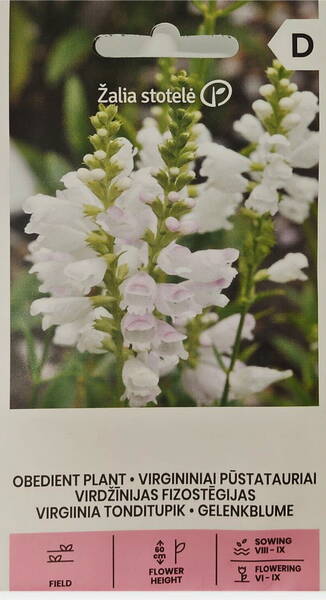Ex Tax: 1.10€
Flowers or seedcapsules for cutting, first year flowering.
VII-IX, Z4-9, 75 cm.
Intense white.
In nature, it is found in damp places in the forests and prairies of the southeastern United States.
The name is formed from two Greek words physalis - "bladder" and stege - "cover" and is explained by the bell-shaped, swollen shape of the perianth. The plant has a creeping, rapidly growing rhizome and strongly branching tetrahedral stems from 60 to 100 cm high. Oblong-lanceolate, serrated at the edges leaves are arranged oppositely and in pairs. Flowers are two-lipped, tubular-swollen, white or lilac-pink, up to 1.5 cm long. They are collected in terminal, dense, spike-shaped inflorescences. In these inflorescences, flowers are located in four rows along the stem.
Flowering - from the end of July to September.
1.0 g = 400-450 seeds.
Physostegia is a wonderful cut flower! It stands in the vase for a very long time, gradually opening one bud after another. Physostegia makes exquisite bouquets, especially in combination with ornamental grasses.
And if you plant physostegia along a fence, it can serve as an excellent screen for lower perennials. Or, on the contrary: planted in front of a tall delphinium, it will be in the shade during its flowering, and later it will hide the not very beautiful dry stems from view.
And another tip: mixed plantings of pink and white physostegia are very beautiful. Just choose varieties that are the same height!
* Physostegia can be grown both in a sunny area and in light partial shade. The soil should be loose, not too light, rich in humus and constantly moist. Physostegia will quickly disappear on poor and dry soil. Plants are propagated by division in spring or late summer, as well as by layering, which sometimes appears at some distance from the mother bush, but does not oppress neighboring plants. Layers are planted in spring or August, in a semi-shaded bed, and the following spring they are placed in a permanent place, at a distance of 45-50 cm from each other.
The plants reach full decorativeness in the second or third year after planting, after which they can bloom well without replanting for another 2-3 years. Then the plants need to be divided or replanted with young grown layers in another place. Physostegia is propagated by cuttings in the first half of summer, and by sowing seeds in the spring or before winter in a semi-shaded area.
Caring for the plants is not burdensome - timely watering, weeding, mulching, as well as pruning of layers that appear outside the planting are necessary. In late autumn, the stems are cut and humus or compost is added to the plants. It is also recommended to cover them with spruce branches, since the roots die off by winter (new ones grow in the spring) and in snowless frosts, physostegia can freeze.
The value of this crop is in its long flowering in the second half of summer. It can be planted in mixed flower beds, where it combines well with plants that have silvery pubescent leaves (stachys, yaskolka), as well as echinacea, which blooms at the same time, with cereals and low, creeping perennials. Physostegia inflorescences can be cut into bouquets, adding asparagus sprigs, all the buds open in water. Just do not cut the stems too low - this will negatively affect the wintering and flowering next year.
Physostegia is a very unpretentious perennial and quite aggressive. It is easier to say where physostegia does not grow than where it does. It tolerates sun, partial shade, and shade. But it quickly degenerates in the shade. Any soil is suitable for it, with the exception of heavy clay. After all, this is a meadow plant, so it is undemanding to the composition of the soil (loam, any garden soil). It is necessary to water only in severe drought, the plant does not like excess moisture. Also, do not pamper physostegia with fertilizers (1-2 times per season is enough). The plant is quite tall, so in a windy place it is better to tie up its stem.
Physostegia rarely suffers from pests, sometimes only the tops are chosen by aphids. After flowering, it is better to cut the shoots, but not flush with the ground, but leaving a small stump.
Propagation: by dividing the bush in spring (this method is most preferable), dividing the rhizomes in autumn, by seeds before winter, and also by green cuttings in the first half of summer.
Wintering. Can be left without shelter, but it is better to cover young plants with spruce branches or sprinkle with dry peat (in case of a snowless winter).
Physostegia has quite a few varieties, but the color range is in the same range: from white to all shades of pink and crimson.
Eng.: Obedient plant "White", False dragonhead.












